-
Posts
4,520 -
Joined
-
Last visited
Content Type
Profiles
Forums
Gallery
Events
Posts posted by Blue Ensign
-
-
A fine looking model Mike, great job on the sails, I'd be proud to display her in my home, very well done indeed.

B.E.
-
Mark, this is what Boudriot has to say about the boat stowage on his 74 gun ship books.
The Longboat rests on boat chocks or small cradles of fir, fashioned to the shape of the lower part of the boat's hull; the first chock is placed abaft the forward ladderway, whilst the second butts against the coaming of the main hatchway. The Longboat is stowed so as not to get too much in the way of the forward ladderway, or the running rigging belayed to the main-topssail sheet bitts.
Looking at the inboard profile plans at 1:72 scale the keel of the Longboat rests about 2mm above the deck when sitting in the chocks which would equate to no more than 6" clearance to the deck.
Boudriot also shows plans for a Longboat, Barge, and Cutter,
I have read somewhere but can't bring it to mind at the moment, that live sheep were kept in pens beneath the boats which would perhaps indicate the chocks being higher to give more clearance. I did in fact include sheep in pens beneath the Long Boat on my small scale French Seventy-four build.
B.E.
-
From small acorns..............
B.E.
-
Following the above, I found a sheet of acrylic and taped it to the table, what a difference in smoothly moving the work around the blade. The much reduced access hole for the blade was also of great benefit in relation to the small pieces I'm cutting out.

Thanks again Intarsiabox, for the tip.

B.E.
-
Well done Martin, she's an attractive build, and such projects are priceless in the experience and confidence they afford us. I have enjoyed your log and your self deprecating humour, and look forward to the great Fly adventure.
Presumably you've informed Bounce of new work to be started in the shipyard

M.
-
Tim,
I use self adhesive micro-porus tape to simulate canvas coverings on small scale models , it has a very slightly textured surface that shows up when painted a suitable colour.
B.E.
-
-
I can't add more to the praise given above Bob, suffice to say I love following your build

B.E.
-
-
What an excellent 'how to' and what a fine result Michael, well done

B.E.
-
Nice work Peter, she's starting to look busy now as the rigging progresses. Love the Ensign, great natural looking hang you've achieved.

B.E.
-
Love that Starboard quarter shot of Wasa Michael, what a class build she looks.
I'm with Nigel on the 'faffing' about trying to make stuff when I can get a quality bought in product, ropes and blocks are a prime example.
'Faffing' is alive and well in these 'ere parts, but then I'm not far from Nigel

B.E.
-
Hi Martin, I love the close-up shots of the gaff and the iron horse, and the rigging is coming along very nicely. Those knot tails are a nuisance, have you thought of using the 'false' splice as shown by Gil Middleton in his Victory build? you can trim really closely and you don't get the problem of tails.
Photographing rigging is a pain but you have answered your own question to an extent; avoiding background clutter is always a good idea, and having a plain coloured sheet behind the shot helps.
I use those large coloured boards you get from art shops, a sort of dusky blue colour is my choice, you can see where I've used it in my log for those shots where I've taken the trouble to set it up properly.
Cheers,
M.
-
Great finish Jason, well worth the effort.

B.E.
-
-
Seriously wonderful stuff Gary, I just love your build.
B.E.
-
Thanks guys I'm glad you like the review, and I hope other novice users who may be contemplating buying a scroll saw will find it useful.
and Mark and Intarsiabox, thanks for your insights; great tips about waxing or covering the table to assist free movement of the work, I did find particularly with the very thin sheet I was using there was some resistance to free movement around the table.
@Yambo - there isn't a ledge to fit an insert in the blade hole which measures 25mm long x 10mm wide. It wasn't too much of a problem except with the very small bulkhead frames. I like the idea of acrylic sheet taped or clamped to the work table top. Will give that a go I think.
Cheers Guys, thanks for responding.

B.E.
-
PROXXON DSH 2 SPEED SCROLL SAW – REVIEW.
This is the second of my recent new toy purchases, and this review as with that for the Band Saw is written from the point of view of a user new to these machines.Unlike the Band Saw there’s no picking this up with one hand, it is a hefty piece of kit with a solid cast base weighing in at 20 kilos.
Actually screwing it down seems superfluous; in my use thus far on a non slip surface it stays where you put it.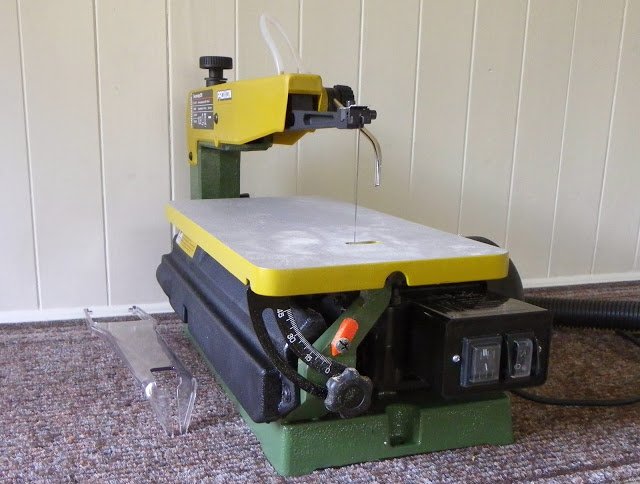
I again purchased the machine from:-
http://www.tbs-aachen.de/Proxxon/table_top_tools/scroll_saws/Proxxon_28092_2-speed_scroll_saw_DSH_i2477_42308.htm
Excellent service, ordered on 26 February, delivered on 28 February and again with a significant cost saving over the UK equivalent supplier.Setting up
The machine was pre fitted with a blade and to get it up and running only required tilting the table to horizontal, and fitting the suction nozzle.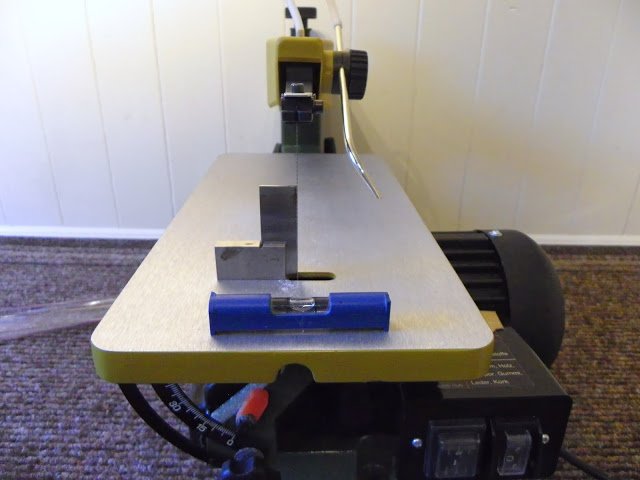
A check with the spirit level and square ensures everything is ok.
The machine comes with five spare blades of coarse and fine each.
Changing the blade was simplicity itself, both pinned and pinless blades can be used, but so far I have only used pinned blades.
I found it much easier than the band saw to get the right tension on the blade. A non flat ‘ping’ when plucked indicates you are there.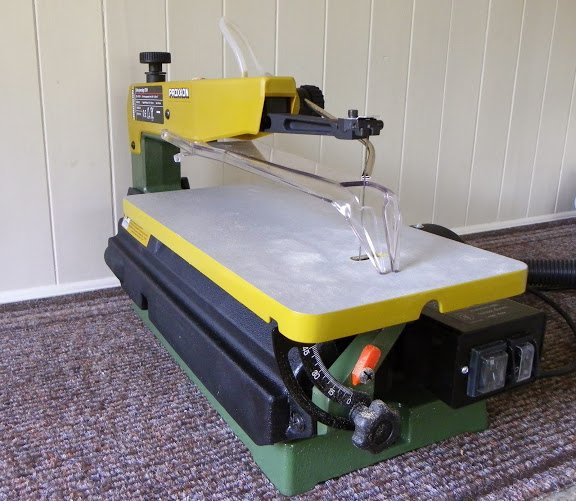
There is a clear plastic blade guard which clips into place. This way for protecting the blade when the machine is not in use.
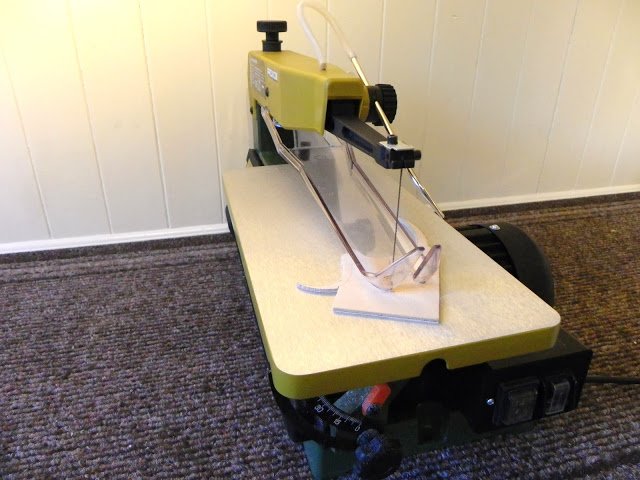
This way when working the machine. A little more fiddly getting the guard into place in its working mode. It is spring loaded in this position intended to also act as a foot to help hold the work piece to the table.
I thought the instruction book somewhat vague on setting up the guard but it gave dire warnings about using the machine without it.
Please note that the saw blade guard is an important safety tool and the saw may not be operated without it but then goes onto say that:
The following describes activities in which the guard may be disassembled expediently but it must be clearly noted that the guard must be mounted again when this work is complete. Operation without this important safety accessory is not permitted.
In my opinion the guard is a severe impediment to effective working, with very small pieces being too large to allow for the necessary close handling.
I looked at quite a few You tube videos concerning the use of scroll saws, some which were of great help. This one is quite misleading.
Supposingly an educational video, it makes great play of safety but shows the blade guard fitted the wrong way up, resulting in trying to work the piece from the side.
Using the machine.
A good sized table, certainly more than adequate for the sort of modelling projects I have in mind.
The machine runs very quietly on low setting and is only slightly more noisy on the high speed setting.
I was keen to see how it would handle cutting out 1:64 scale Pinnace frames for my prototype practice build.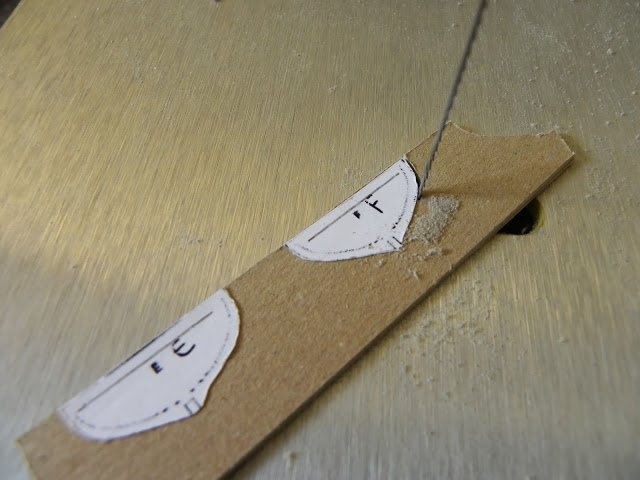
I would not be able to cut a frame like this with the guard in place. I am using stiff card for the frames, so not much of a challenge to the blade.
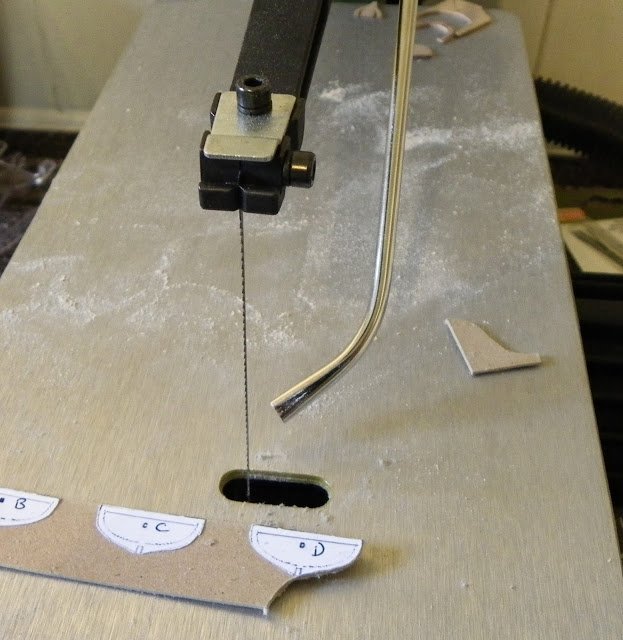
But the idea is to practice the scrolling.
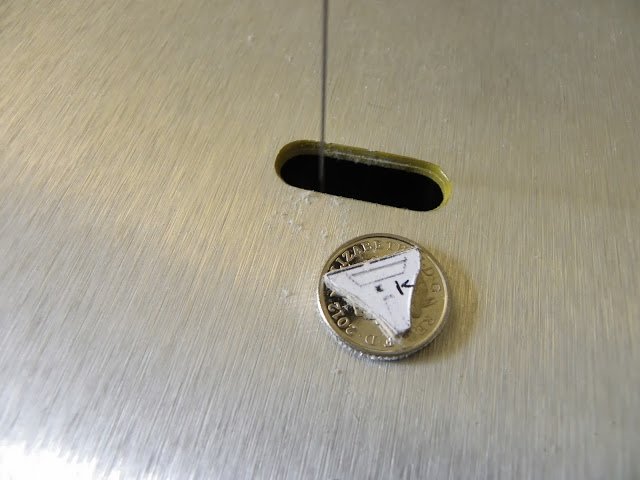
This is one of the smallest frames, fits inside a 5p piece. With the guard in place it would be impossible to get close enough to support the cut edges whilst scrolling.
With such small pieces you need to work out how to approach the job as your fingers get perilously close to the blade at times.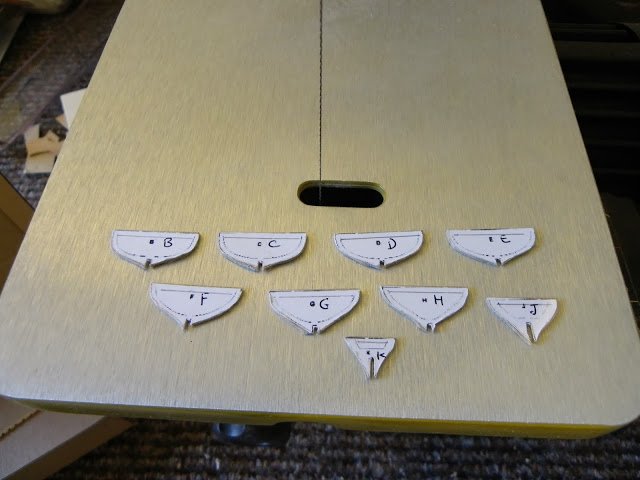
Frame cutting progressing....

There is a blow nozzle to keep the work piece free of dust whilst scrolling, but it didn’t seem to have much blow in it!
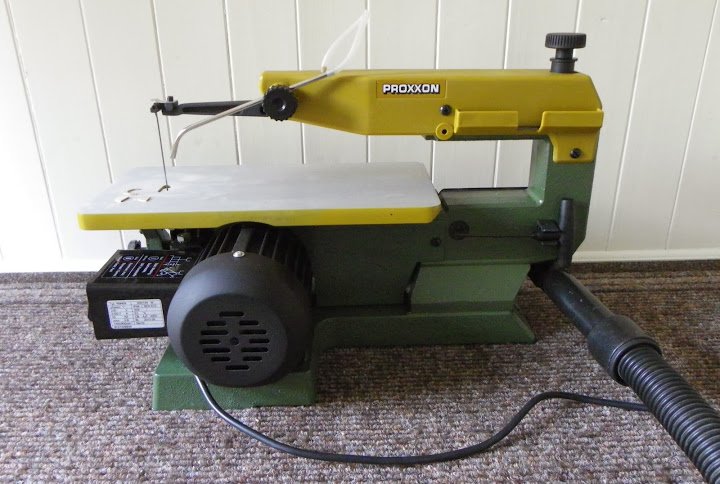
The vacuum attachment is at the rear of the machine, the quietness of the machine is negated once the vacuum is switched on.
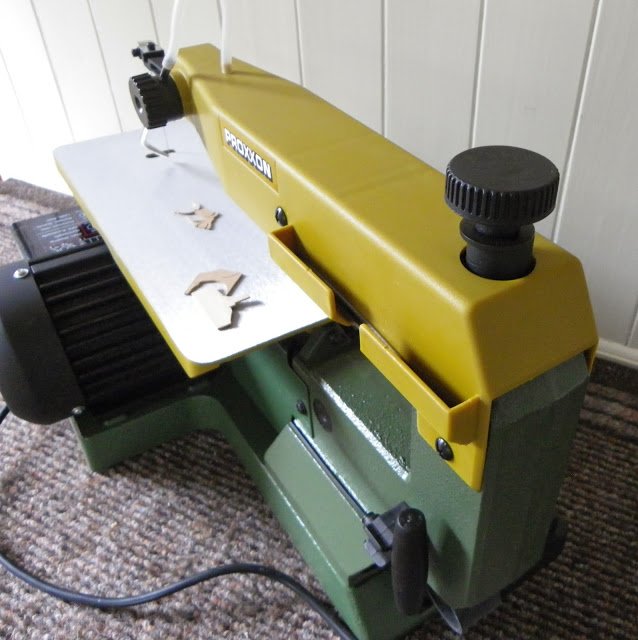
The large knob is used for tensioning /releasing the blade, the allan tool for removing the blade is clipped to the side of the machine. There is a narrow tray for holding spare blades.
Moving the machine around
Unlike all the other Proxxon modelling machines I have, the weight of this machine really dictates that a designated place for storage/working is the best option.
Whilst I can use the Mill, the wood lathe, and the band saw on my desk, and then store them away, I really don’t fancy lumping this around particularly with my slightly suspect back; the heavy cast base would cause serious damage if dropped, whether to toes or tiled floors.
Verdict.
Costing around £134 this is a lot of machine for your money. Seems well built and is smooth running, maybe not as portable as some other modelling machines, but certainly a useful addition to the modellers workshop.If space and portability are important and light small scale scrolling is the requirement then the much smaller, cheaper, and significantly lighter DS230E model may suit.
B.E.
- CaptainSteve, riverboat, Keith_W and 9 others
-
 12
12
-
Nic shots of Snake Jason, I like the look of models with just the lower masts and standing rigging in place. The ratlines look good to me and your clamping arrangement should also help guard against pulling the shrouds out of line.
B.E.
-
Nice progress Lukas, she does look good on the water. Glad my effort has helped with your build.

B.E.
-
-
-
Thanks QAR

Hi Keith
The Band saw can deal with heavier gauge stuff, is more robust, can still cut fairly tight curves, but for very small delicate work a scroll saw is probably more appropriate. I would envisage using the band saw for many of the tasks I would otherwise use the table saw for.
Hi Tom,
85mm is the maximum cut height.
My cutting mat measures 90 cm x 60cm and I got it from a supplier in the UK Cost £26.95
http://www.creativegrids.com/acatalog/Industrial_Cutting_Mats.html
Thanks for your input Jud, I like the idea of buying cutting mats by the foot, very large mats in the UK cost an arm and a leg.

Cheers,
B.E.
- WackoWolf, usedtosail, Q A's Revenge and 1 other
-
 4
4
-
Proxxon Micro MBS 240/E Band Saw Review
Since I posted my new toy on my build log it has been suggested I write a review of this Band saw.
This is really first impressions by a novice user.
It may be of interest to those in the UK that the machine was purchased not from Chronos the UK Proxxon dealer, but from TBS- Aachen in Germany. Delivery was very quick, I was able to pay by Paypal, and there was a saving of £52.72 over the Chronos price, including a modest postage charge.
A few general shots

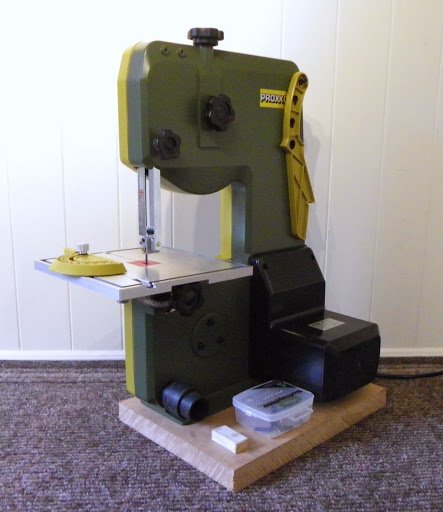

Note the push stick hanging on the side of the machine, this is included.
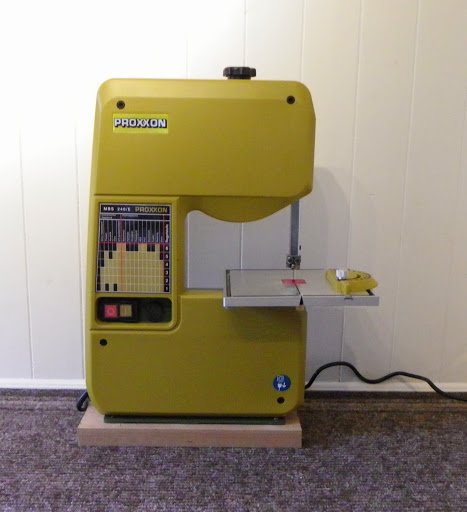
First impressions.
This is the largest of the Proxxon tools I have, measuring 19½" high x 15½" deep x 11" wide. (including the motor on the side, and the table) It sits on a base of mdf 1” thick, 9¼" wide x 12¼" deep. The machine feels sturdy, it is quite stable, but portable, and I can pick it up one handed.
As can be seen below it sits comfortably on my desk.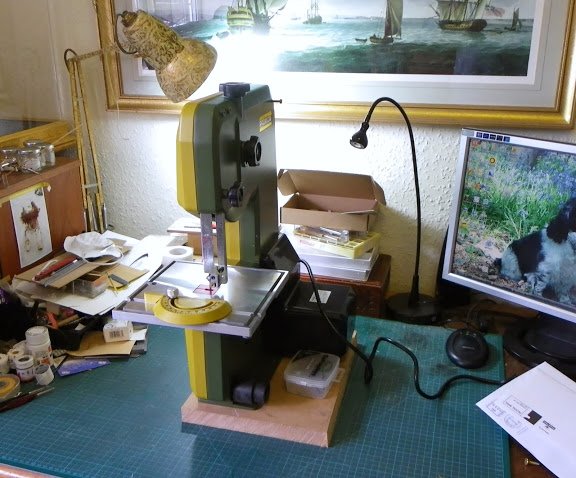
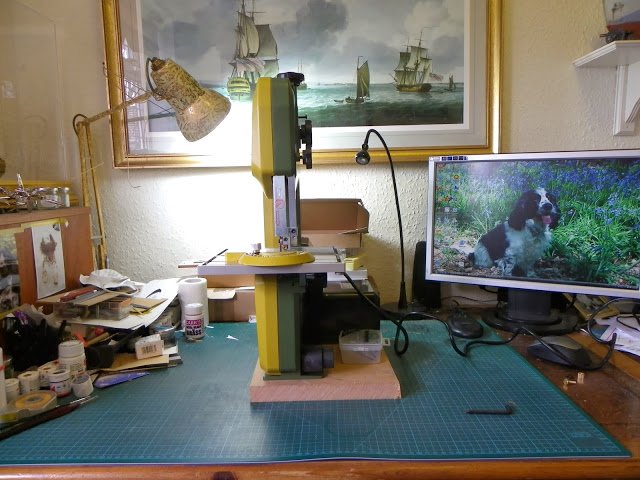
The machine arrived with a standard blade already fitted, and all that was necessary to set it up was to attach the table and get familiar with the operations.
I found it useful to photocopy the exploded views in the manual so easy reference could be made to the parts etc; when reading the text.Changing blades is fairly straightforward but as a complete novice with band saws it would have been comforting to have some sort of tensioning gauge when fitting blades rather than the narrative dire warning:- putting too much tension on the blade can tear apart and damage the device.
How much tension is too much tension, should there be any lateral play in the blade at all or should it feel rigid when pressed from the long side. It seemed to me that there is a range of tensions where I can’t detect differences in performance, but which is the optimum one.
Tensioning is done by degrees using the knob on top of the machine, best done with the cover off where the blade can be felt. I worked on the basis of when there was minimal play in the blade on the long side and the motor ran quietly, it was about right.
Access to the internals is via four Allan bolts to remove the cover which remains attached to the machine via a chain. A hinged door system would have made for quicker adjustments/cleaning.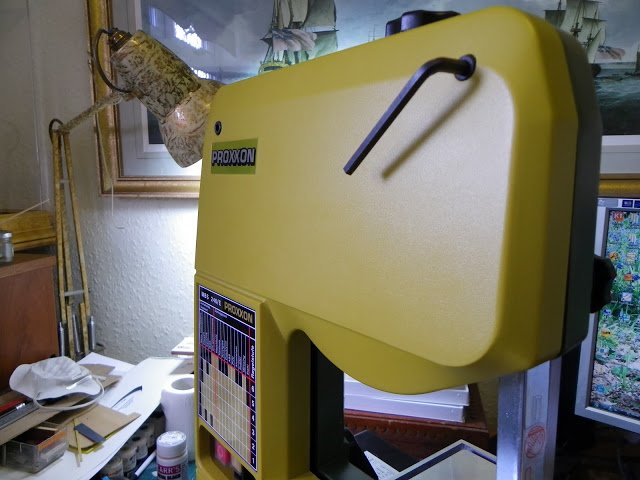
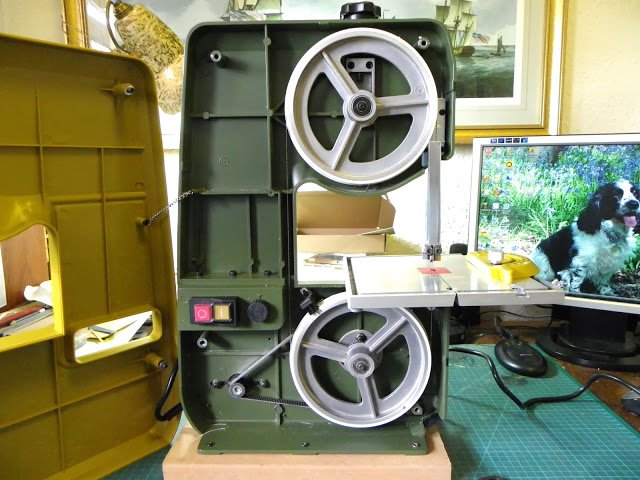
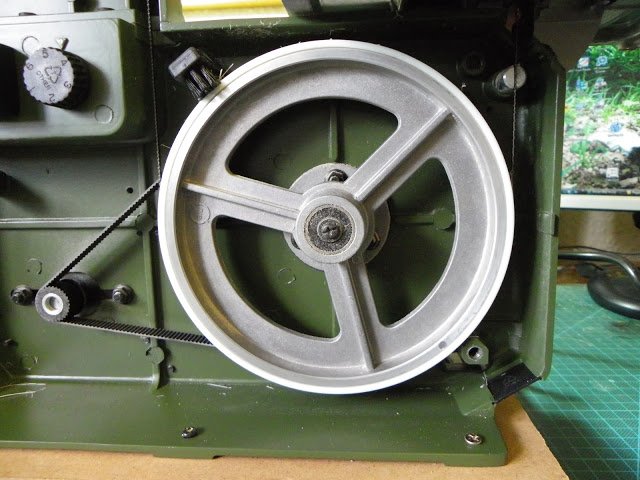
The lower running wheel with the drive pulley attached. The wheels have a plastic cover around them over which the saw blade runs. In the photo you can see a brush which clears away bits of plastic scuffed off the wheel. These are replaceable items and I have noticed that the rate of wear changes depending on the tension, but again as a novice user it is difficult to know what is normal for this machine.
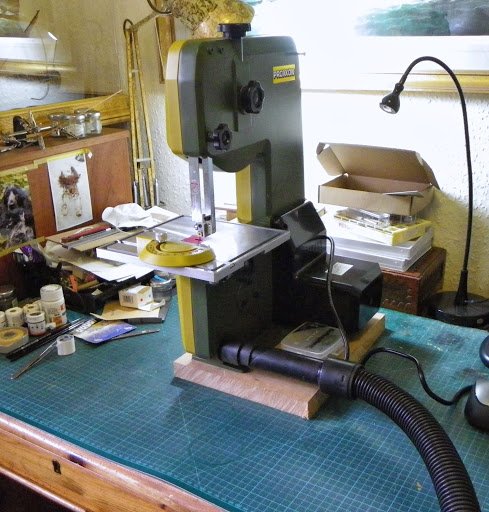
The machine has quite an efficient dust clearing system using the vacuum cleaner hose attachment.
Using the machine.
My initial use was limited to practising curved cuts on scrap wood which it easily accommodated. I progressed to cutting out the keel and false keel for my attempt at a 1:64 scale Pinnace.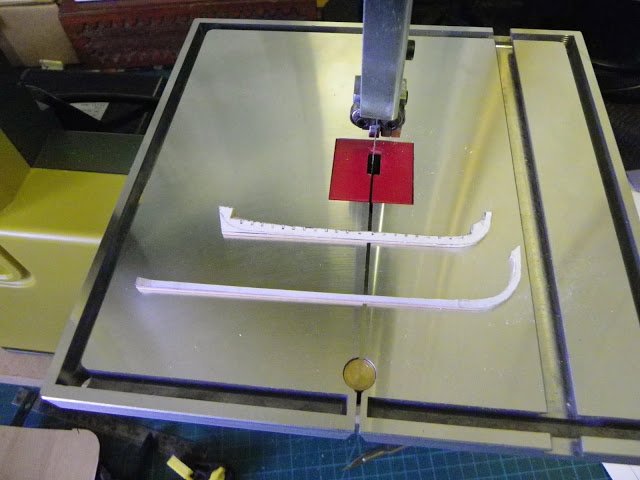
This is fairly fine stuff using 1.5mm boxwood sheet, and it (or perhaps me) struggled a little with the internal curves given the scale.
I rather think a scroll saw would be more suited to the job, and certainly for the boat frames which are quite small.
Even so this is a very useful addition to the workshop and apart from cutting more complex shapes it will replace my table saw for many jobs also.
Here’s the official video of the machine.
Any member who has perhaps more experience in using this particular machine please feel free to comment.
B.E.
- Landlubber Mike, tkay11, Yambo and 16 others
-
 19
19


HMS Agamemnon by mobbsie - FINISHED - Caldercraft / Jotika - 1/64
in - Kit build logs for subjects built from 1751 - 1800
Posted
Very nice work mobbsie, the snaking looks impressive... but.... Thanks to B.E. this is his method, I got to this spacing after some simple maths, 12mm on each Stay or 6mm combined .I may be having another senior moment, but are you sure it's me you're referring to, I can't for the life of me think I've posted anything about snaking. I'd hate your thanks to go to the wrong person.
I'd hate your thanks to go to the wrong person. 
B.E.